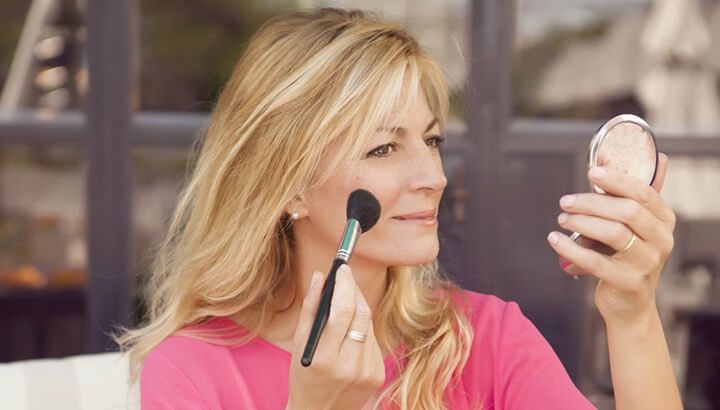Most of us use dozens of shampoos, lotions, serums and scrubs on a daily basis, but now researchers are finding evidence that makeup can be the most damaging of them all. With millions of products on the market, it can be challenging to figure out which products have good ingredients and those you should not use at all. If you’re not careful, looking glamorous can come with a hefty price when it comes to your health.
Always read the labels
Reading makeup labels will allow you to see a list of individual ingredients, but even this information is totally useless unless you know which ingredients should be avoided. Makeup companies are often pretty shady with their list of ingredients as they typically list them in a font that is too little to read. Or, they’ll include terms like “All Natural,” “Organic,” or “Healthy.” Harmful ingredients can be easily disguised with deceptive titles like “fragrance.” Beauty brands are free to put just about anything they want into cosmetics.
Whether you’re a makeup guru or use makeup sparingly to pep up your look every blue moon, it’s vital to know what you’re putting on your skin. Read on to discover the scary ingredients lurking in your makeup.
1. Phthalates
There have been many recent reports about potential reproductive or developmental toxins in cosmetics and personal care products. One of the primary dangerous ingredients are phthalates. Phthalates are the key components in plastics that are found in many beauty products. The main type of phthalate found in cosmetics and personal care products is diethyl phthalate. Phthalates are used to moisturize and help chemicals absorb into the skin. The unfortunate side is often times phthalates are not listed on labels since companies are not required to reveal the ingredients making up fragrance mixtures on the labels of products.
The Centers for Disease Control performed a study in 2004 which revealed that 97 percent of 2,540 individuals tested had been exposed to one or more phthalates. The Harvard School of Public Health also conducted a study highlighting the link between urinary phthalate metabolite concentrations and DNA damage in human sperm.
The presence of chemicals in makeup doesn’t affect just women. Fellas, listen up, you’re at risk too! If your lady frequently wears makeup, it can affect your testicular health. Phthalates cause a variety of reproductive problems in men, including small or abnormal testes, hypospadias (also known as abnormal urinary openings) and undescended testes. Phthalates have also been linked to asthma as well.
2. Talc
Talc is a mineral used in talcum powders and cosmetic powders, like face powders and eyeshadows. It’s made from magnesium, silicon, hydrogen and oxygen. Talc that isn’t purified can be contaminated with asbestos, which is a known carcinogen.
Inhaling talc may cause lung fibrosis by creating the formation of granulomatous nodules, called talcosis. Using talcum powder in closed spaces may increase the likelihood of inhaling the powder laced with asbestos. Extended exposure to talc may be a factor in the development of ovarian carcinomas, gynecological tumors and mesothelioma in women.
During a study, 20 consumer products labeled as talc or talcum powder, including body powders and facial talcums, were tested for harmful properties. Of the 20 products tested, ten were found to contain tremolite and anthophyllite, also known as asbestiform. Talc has also been identified as the same ingredient that causes mesotheliomas in New York talc miners.
3. Parabens
Parabens can mimic estrogen, and have been found in human breast cancer tissue. They also interfere with reproduction, the nervous system and the immune system, which sounds horrific! Because parabens mimic estrogen, the natural hormone women produce, exposure to external estrogens have been linked to an increase risk of breast cancer. Parabens are preservatives used in many cosmetics to keep them fresh and germ-free. Other names for parabens are methylparaben, propylparaben, butylparaben or ethylparaben.
The Environmental Working Group (EWG) conducted a study that revealed young women are frequently exposed to parabens from cosmetic preservatives. Two parabens, methylparaben and propylparaben, were found in every single girl tested. Studies show that daily makeup products may contain about 17.76 grams of parabens for adults.
4. Formaldehyde
Formaldehyde is a colorless gas with a strong smell that is used in wood products such as plywood and glues, but did you know it is also used in makeup? The primary ways formaldehyde enters the body is through inhalation or absorption into the skin from liquid forms. Once formaldehyde is in the body, it can cause nausea, coughing, skin irritation, and burning sensations in the eyes, nose and throat.
For those with extra sensitive skin, using makeup containing formaldehyde can cause severe allergic reactions and rashes that if left untreated, could cause blisters. Studies show a concentration of formaldehyde in cosmetic products even causes dermatitis on normal skin.
Even though formaldehyde is rarely used in makeup anymore, preservatives that release formaldehyde in the presence of water are still used in many makeup products. These preservatives are called formaldehyde-donors or formaldehyde-releasers. The scary part is, studies have discovered, some products that don’t say they contain formaldehyde-releasers or formaldehyde still release very small amounts of formaldehyde.
Create your own beauty products instead
Before you panic and assume you’ll never be able to get dolled up again, consider creating your own beauty products. I promise, it’s not as hard as it sounds! Creating your own products allows you to know exactly which ingredients you’re absorbing into your skin. You’ll also help the environment by reducing packaging waste and chemical compounds in the environment. Check out this easy homemade skin scrub recipe.
If you’re not a DYI type of gal, try using the Cosmetics Database to research other harmful ingredients that could be hiding in your favorite makeup products.
What harmful ingredients have you cut out of your beauty routine? Leave your comments below!
— Susan Patterson

